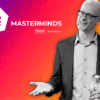

By Gary Flood, Senior Journalist, The HR Congress
Our profession’s largest online event on HR Strategy & Leadership, HR Congress World Summit was held at the end of November 2022. We’re now revisiting some of the excellent Keynotes, plenaries, panels, and interviews to aid you in your learning journey. Today, let’s go back to how we concluded the morning plenary session of Day 1 with the CEO of The HR Congress, Mihaly Nagy’s interview with Orgonomics’ CEO, Joan Lurie
WHY SHOULD YOU CARE?
Flipping the way the HR practitioner sees an organization as a complex network, not as a collection of individuals and their respective feelings and motivation, would need some education, she acknowledged, especially around social psychological concepts like complexity theory.
Ask developmental psychologist and acclaimed thought leader in the field of systems thinking and change. Joan Lurie what she thinks is holding HR back from finally dissolving today’s workplace issues, and she has an answer that isn’t the ‘standard’ one.
“We’ve made assumptions about the world of work and organizations through two dominant world views,” she told HR Congress’s Founder, Mihaly Nagy.
For Lurie, these two lenses have historically been either a technical one, or a more psychological one.
The ‘technical’ way to understand an organization as a set of processors and structures–like machines we need to somehow optimize without taking human behaviour into account.
That has been superseded, she said, by a shift to instead looking to achieve change and progress though psychologically motivating people and improving how they function at work by more of a focus on how people interrelate and interact.
Lurie thinks the latter is better than the former—but has ended up as being too focused on employees as individuals, and not the sociology of the organization they work in.
“We started thinking about how to look at the world of work largely through the lens of the individual,” she told delegates.
“But I think there’s a whole other way of making sense of work and organizations, which is to see them as complex systems.”
That helps, she said, because if we start seeing how workplace behavior doesn’t come from just the individual but rather behavior comes from the interactions between individuals–from the patterns of relating.
The result, she believes, is that, “If we start to see organizations as networks and that behavior is an emergent property that belongs to the patterns of interaction, then we start to understand they can’t be optimized and reduced to some of the parts.”
Flipping the way the HR practitioner sees an organization as a complex network, not as a collection of individuals and their respective feelings and motivation, would need some education, she acknowledged, especially around social psychological concepts like complexity theory.
Why would we want to go to all this trouble (or ‘reframing,’ to use her language)? Lurie’s claim is that it’s the missing step to really make our interventions effective:
“HR practitioners can start to see themselves not only as there to engage and motivate people and optimize how they function—either through a technical lens of training and skills, or through a psychological lens of the value systems that people hold–but instead be able to think about improving the interconnectivity and patterns of relating between the roles and between the parts of the system that are actually more important than individual psychology.”
From HR specialist to organizational ecologist?
The ultimate endpoint of this reframing, she contends, is for the HR practitioner to see themselves as “organizational ecologists”—empowered to see organizations as complex ecosystems.
They might also then have the right tools at last to create healthy, thriving ecologies where individuals and people can then thrive—but also the organization, too.
In practical terms, that might mean working less on optimizing a work process or looking purely at personality profiling or 360 degree feedback but discovering the hidden systems that employees are subject to–and then disrupting these patterns of interrelations, which could be much more impactful.
She left us with a fascinating metaphor for this evolution in HR, which she modestly says she has borrowed from Ron Heifetz:
“You need to step up onto the ‘balcony’ to see the ‘dance’ below.
“That’s the only way you’re going to be able to see the system and how it’s working.”
Intrigued?
Then watch Ms Lurie’s whole interview right here:
Written by: Mihaly Nagy
Culture Performance Management Talent Talent Management
Previous post

- 330
- 1
labelArticles today2023.01.23.
Agenda for 2023
Organizations With More Owners and Fewer Renters By David C Forman, Author of Fearless HR and Fearless Talent Choices WHY SHOULD YOU CARE? The one thing we know [...]
Similar posts

labelArticles today2024.10.21.
The success-recipe to build agile and future-ready organizations in 2025 and beyond








Post comments (0)